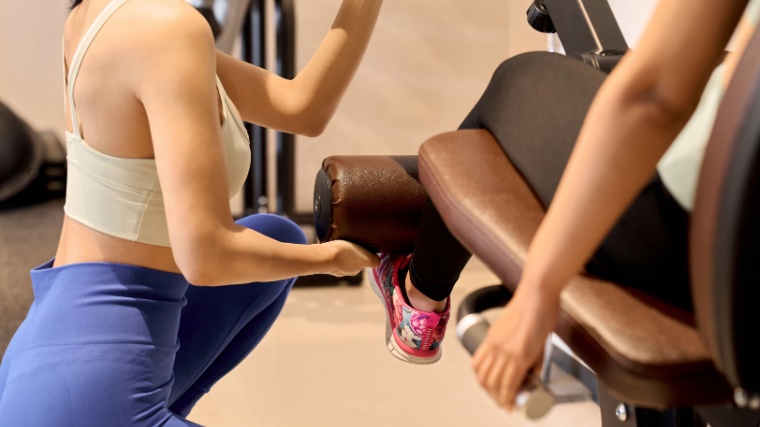Phone a friend. If you’re trying to build muscle — as much of it as you can — you might need to recruit a spotter, even for machine exercises. At least, according to renowned bodybuilding coach Joe Bennett.
Bennett works with some of the best bodybuilders in the game, including former Women’s Physique Ms. Olympia Dana Linn Bailey and two-time Arnold Classic champion Terrence Ruffin.
[Related: Best Pre-Workout Supplements for Bodybuilding]
Lucky for us, Bennett isn’t shy about sharing his wisdom. During a Jul. 30, 2024 leg workout with Women’s Figure pro Melissa Brodsky, Bennett took a beat to explain in detail why he thinks having a spotter on machine exercises can enhance muscle growth. Let’s take a look at what “the Hypertrophy Coach” has to say.
Why You Need a Spotter on Machine Exercises
So, here’s the thing. Gym machines are touted for their safety, specifically because you aren’t at risk of dropping a weight and damaging the equipment, gym floor, or hurting yourself. That’s all true.
But Bennett’s argument regarding spotters on machine exercises is rooted in biomechanics. “A lot of people talk about task failure, but what they don’t realize is that task failure is dependent on the loading pattern of the exercise,” he says.
- What Is Task Failure?: “Task failure” is another name for training to failure. Specifically, it describes maximal voluntary muscle contractions, or “hitting the wall” and being unable to move a weight any further by relying solely on muscle strength instead of momentum or assistance.
More specifically, he explains that many gym machines contain a gadget called a cam which enables rotational motion; think of how the heel pad of a leg curl machine swings in an arc under your thigh.
- “The design of the machine,” Bennett explains regarding mechanisms like cams, “determines where you hit failure in your range of motion. When I spot someone [on machine exercises], I’m fixing the resistance profile.”
Machines (and cables) are often lauded for their smooth and stable resistance, since the weight isn’t being directly acted on by gravity. However, that doesn’t mean a machine exercise like the seated leg curl is equally difficult from start to finish.
By providing manual assistance to the hardest part of the range of motion, Bennett helps his bodybuilding clients push past their own limits, adding additional training volume and driving up mechanical tension.
Is Bennett Supported by Science?
So, is Bennett blowing smoke? The short answer is no — and, in fairness, so is the long answer. Here’s what the science has to say:
- Studies indicate that mechanical tension is the primary driving force behind muscle hypertrophy. (1) The more tension you can create, the better your muscles respond.
- Muscles are not uniformly strong at all lengths. (2) Think of your lats during pull-ups, which are easy at the bottom and incredibly difficult at the top.
- Research tells us that applying tension to a muscle in the lengthened position seems to create more growth than any other range of motion. (3)
- Machine exercises have been shown to be just as effective at building muscle as free weights. (4) They’re also easier to spot.

[Related: Best Multivitamins for Women]
Putting it all together, a good spotter can help you build more muscle by providing a bit of “oomph” to help you push through the hard part of a machine exercise’s range of motion.
Bennett makes an example of the seated leg curl, which is most challenging at the beginning and gets easier as your hamstrings contract and shorten. Like giving a child a push on a swing set, having a spotter “get you going” on the leg curl enables you to lift more weight through the most valuable portions of the range of motion.
From the Expert: If you want “astronomically huge” hamstrings, Bennett advises using a seatbelt on the leg curl to help stabilize your hips and improve your leverage to lift more weight.
Your Next Move
Unlike powerlifting spotting which focuses mainly on the safety of the lifter, spotting in bodybuilding is a delicate skill.
If you’re going to incorporate manual assistance on machine exercises, make sure you instruct your spotter to provide only a small amount of assistance through the sticking point of the exercise. The spotter should not be doing most of the work.
More Bodybuilding Content
- The Most Overlooked Factor for Lower Chest Development (Says Jay Cutler)
- Will Big Ramy Compete at the 2024 Mr. Olympia Contest?
- Hany Rambod’s Hamstring & Glute Training Tweaks for Chris Bumstead
References
- Schoenfeld B. J. (2010). The mechanisms of muscle hypertrophy and their application to resistance training. Journal of strength and conditioning research, 24(10), 2857–2872.
- Stasinaki, A.-N.; Zaras, N.; Methenitis, S.; Tsitkanou, S.; Krase, A.; Kavvoura, A.; Terzis, G. Triceps Brachii Muscle Strength and Architectural Adaptations with Resistance Training Exercises at Short or Long Fascicle Length. J. Funct. Morphol. Kinesiol. 2018, 3, 28.
- Pedrosa, G. F., Lima, F. V., Schoenfeld, B. J., Lacerda, L. T., Simões, M. G., Pereira, M. R., Diniz, R. C. R., & Chagas, M. H. (2022). Partial range of motion training elicits favorable improvements in muscular adaptations when carried out at long muscle lengths. European journal of sport science, 22(8), 1250–1260.
- Haugen ME, Vårvik FT, Larsen S, Haugen AS, van den Tillaar R, Bjørnsen T. Effect of free-weight vs. machine-based strength training on maximal strength, hypertrophy and jump performance – a systematic review and meta-analysis. BMC Sports Sci Med Rehabil. 2023 Aug 15;15(1):103. doi: 10.1186/s13102-023-00713-4. PMID: 37582807; PMCID: PMC10426227.
Featured Image: @melbro_ifbbpro / Instagram